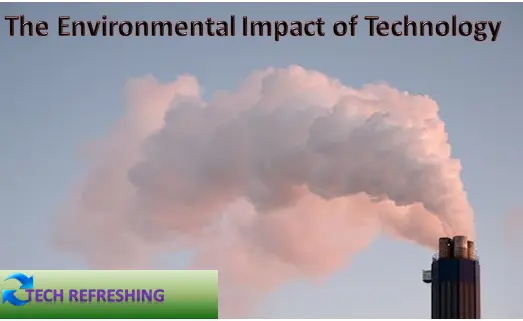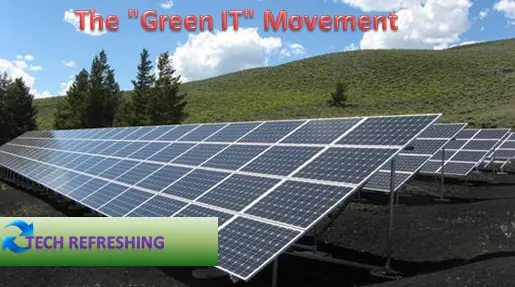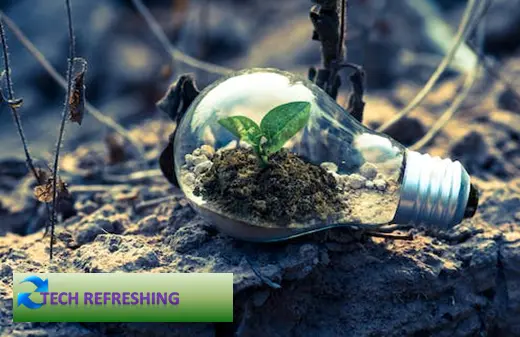The advancements in technology over the recent years have brought to light its potential adverse effects on the environment. The effects of technology on the environment are becoming clear as it continues to play a bigger part in our daily lives. The technology sector leaves a carbon footprint that is difficult to ignore from the creation and disposal of electronic devices to the energy required to power them.
However, technology can also be a potent weapon in the struggle against climatic change and environmental deterioration. The “Green IT” movement, which aims to reduce technology’s negative environmental effects and promote sustainability, steps in at this point.
The Environmental Impact of Technology

It is important to not undervalue how the technology sector affects the environment. The industry has a long-lasting effect from the mining of raw materials like minerals used in the manufacture of electronic products to the energy-intensive manufacturing procedures. The issue of climate change is made worse by our reliance on non-renewable energy sources and the production-related emissions of greenhouse gases.
There is growing worried over the rise of electronic garbage (e-waste). The issue of disposing of electronic waste is getting worse as long as there is a desire for electronic gadgets. If not properly managed, harmful materials like lead, mercury and cadmium found in e-waste can affect the environment and people’s health.
Technology has a broad and profound effect on the environment. Three of the primary ways that technology has an impact on the environment are as given below:
Energy consumption
The widespread use of technology has resulted in an exponential rise in energy consumption. For instance, using smartphones, laptops and other technology devices more frequently in our daily routines has led to an increase in energy demand. This heightened demand has a profound impact on the environment, exacerbating issues such as the rapid depletion of non-renewable energy sources and a rise in greenhouse gas emissions.
The production of technology devices itself is also energy intensive, further compounding its overall impact on the environment. In essence, the proliferation of technology has resulted in a significant increase in energy consumption and has an extensive impact on the environment.
Electronic waste
Rapid technological advancement leads to fast obsolescence of tech devices, which are often discarded as e-waste. E-waste disposal can have severe environmental impacts as many tech devices contain hazardous substances such as lead, mercury and cadmium. Improper disposal can result in the release of these toxic materials into the environment, posing a threat to human health and the environment.
Carbon footprint
As members of the global community, our actions contribute to the lifecycle of technology devices from their inception to eventual use and disposal. This creates a carbon footprint, which serves as an indicator of the impact these devices have on our environment, including the release of dangerous greenhouse gases into the atmosphere. Regrettably, the technology industry has a heavy carbon footprint, with large amounts of carbon dioxide being produced during the manufacture and utilization of tech devices. We must acknowledge our part in this problem and work towards finding more sustainable solutions to reduce the carbon footprint of the technology industry and protect our planet.
It’s critical that we, as humans, comprehend and accept the wide-ranging and significant effects that technology has on our environment. If we want to guarantee a sustainable future for ourselves and future generations and maintain the health of our planet, we must act proactively to address these impacts.
The “Green IT” Movement

The “Green IT” movement seeks to reduce technology’s negative environmental effects and advance sustainability. This can be done in a number of ways, such as by designing energy-efficient technology, utilising renewable energy sources and putting sustainable disposal procedures into practise.
The “Green IT” movement which involves a wide range of initiatives aimed at reducing the environmental impact of technology. The following are three of the main “Green IT” initiatives:
Energy-efficient devices
The creation of energy-efficient equipment is one of the main “Green IT” projects. Energy-saving gadgets have a less environmental impact since they use less energy and emit fewer greenhouse gases. This can be done by using energy-saving parts, like low-power processors, or by designing gadgets that can be turned off or put into sleep mode when not in use.
Renewable energy sources
The utilization of renewable energy sources, such as solar and wind power, is another significant initiative within the realm of “Green IT.” These energy sources emit fewer harmful greenhouse gases and do not deplete non-renewable resources. Adopting these renewable energy sources can help the technology industry lower its carbon footprint and contribute to a more sustainable future.
Sustainable disposal practices
Promoting environmentally friendly disposal methods is another aspect of the “Green IT” movement. This covers the ethical disposal of electronic trash and the utilisation of recycled resources in the manufacture of technological apparatus. The technology sector can lessen the effects of e-waste on the environment and help to create a more sustainable future by implementing sustainable disposal techniques.
The “Green IT” movement involves a variety of initiatives aimed at reducing the environmental impact of technology. These initiatives include the development of energy-efficient devices, the use of renewable energy sources and the promotion of sustainable disposal practices. By adopting these initiatives, the technology industry can contribute to a more sustainable future and help to protect the environment for future generations.
The Benefits of “Green IT”

The “Green IT” movement offers numerous benefits to the technology industry and society as a whole. The following are four of the main benefits of this movement:
Cost reduction
The possibility for cost savings is one advantage of the “Green IT” trend. The cost of running technology infrastructure can be decreased by consuming less energy and relying more on renewable energy sources. This can lessen the carbon footprint of the technology industry while simultaneously increasing access to technology for people and businesses all around the world.
Improved reputation
The “Green IT” movement also offers the advantage of enhancing the image of the technology industry. As customers become more environmentally aware, they seek ways to make eco-friendly choices. By showing dedication to sustainability, the technology sector can enhance its reputation among consumers and promote a more sustainable future.
New business opportunities
The “Green IT” trend may open up new commercial prospects. New jobs can be generated and economic growth boosted by the development of energy-efficient technology, renewable energy sources and environmentally friendly disposal methods. This not only lessens technology’s negative environmental effects but also improves the state of the economy as a whole.
Preservation of natural resources
The “Green IT” movement can help to preserve natural resources for future generations. By minimizing the environmental impact of technology, the “Green IT” movement can help to ensure that natural resources are not depleted and that the environment is protected for future generations.
The “Green IT” movement holds many advantages for the tech industry and humanity all together. By cutting down on electricity usage, using renewable energy and encouraging responsible disposal methods, the “Green IT” movement can play a role in creating a more sustainable future and guarding natural resources for future generations.
Conclusion
We should focus on the significant issue of how technology affects the environment. The “Green IT” movement is a critical effort in tackling this issue by minimising the environmental harm caused by technology and promoting sustainability. The use of green energy sources, the reduction of energy consumption and the promotion of environmentally friendly disposal practises are some ways that the technology sector may lower its carbon footprint and contribute to a cleaner future.
The “Green IT” movement not only helps to reduce the environmental impact of technology, but it also brings numerous benefits to the technology industry and society as a whole. It is time for the technology industry to take a leadership role in promoting sustainability and protecting the environment for future generations.


